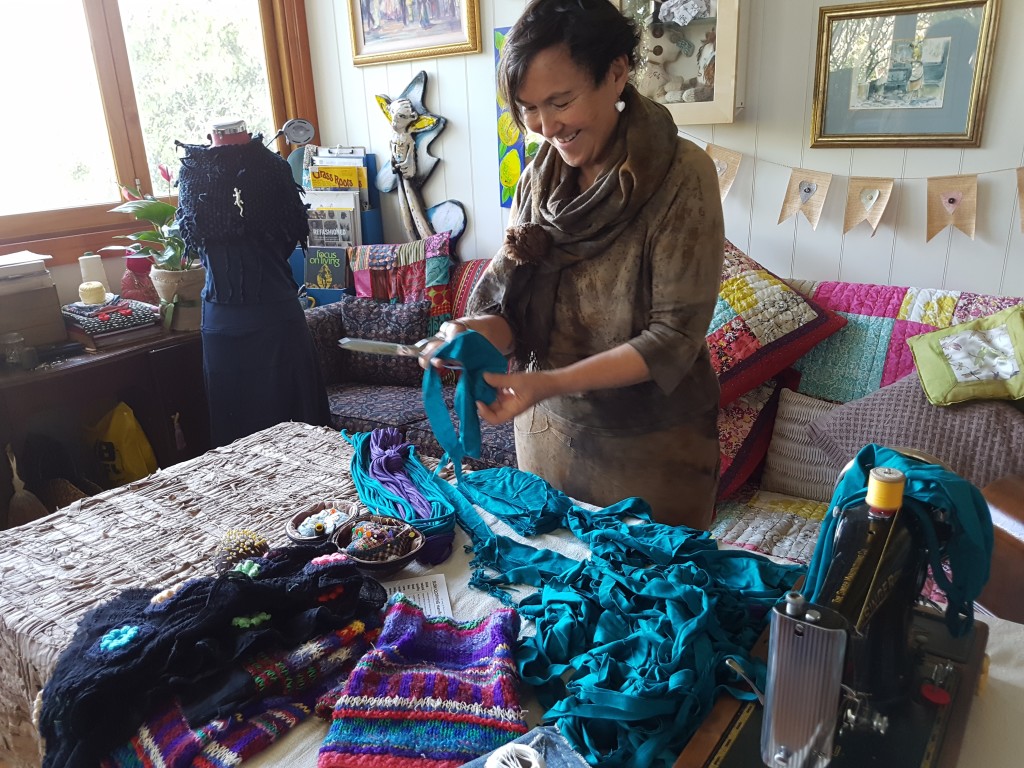I rescue natural fibres. I already have many, yet I bought a $2 wool blanket with holes at an RSPCA op shop recently. It has no label, just remnants of blanket-stitched edges. I know it is wool by the feel of the fibres which glow in the sunlight after I wash it. I admire the texture and beauty of the old woven threads. There is life there. I will upcycle this ‘dog blanket’ into a garment with a story to tell about how it came to be.
All my clothes are handmade or secondhand and they feel good on many levels. My clothes are imprinted with individual spirit, my kansei. I refashion existing garments to suit my body shape, or completely transform discarded resources into something of my own making. I buy almost nothing new, except underwear and shoes.
Even though I have bought secondhand on and off forever, I did not talk about it. There was a stigma of poverty, of less than, in secondhand although vintage was OK if slightly quirky.
That was before I stepped up, before I did leadership study and learned about self-actualisation, before I upcycled my career as a rural advocate and communications manager to found a start-up called Textile Beat in 2013. Now I champion slow clothing, raise awareness of textile waste and the potential for upcycling old natural fibres into new.
We eat and dress every day to survive and thrive. Our clothes do for us on the outside what food does inside. They protect and warm our body – and influence the way we look and feel.
We love cooking and baking food because it brings satisfaction, we know what goes into it and we eat to our own taste. Yet we almost completely outsource our clothing needs to a global marketplace thriving on social and environmental inequity.
There are ethical issues arising from the transformational shift in the way we source, use and discard garments. At no time in history has there been so many clothes in the world. Clothing is at its cheapest as global companies access low-wage labour (and in some cases modern-day slaves) in developing nations.
This outsourcing of clothing needs has led to a population-wide loss of knowledge of the making process and fostered disregard for the energy involved. Fast fashion is often seen as disposable and textiles have become the fastest-growing household waste stream.
Every year another 100 billion* new garments are added to the stockpile. The majority are now synthetic fibres derived from non-renewable resources such as petroleum and known to be shedding microplastic into the ecosystem.
I am proud to spring from the second-wave feminist era that sees Western women embrace education and professional work while diminishing focus on domestic duties. Yet this – along with the busyness of modern lifestyles – contributes to the general absence of simple sewing skills, inability to repair a garment or resew a button. That manifests in dependency, lack of autonomy and waste.
Until we make something for ourselves to wear, we cannot appreciate the resources, time and skill that go into the clothes we buy. And in the rush to own fashionable things for reasons of status and looks, we lose the opportunity to be mindful and resource by making and creating.
The choices we make when we dress each day influence the kind of world we live in. It is through individual action that we can collectively reduce the astounding waste hidden in clothing habits.
Wearing secondhand is sustainable: suddenly the first choice of many champions. As we wake to changing climate realities we see smaller carbon footprints spring from everyday practices, personal and lifestyle choices. Socially aware groups advocate for secondhand first before a circular economy can close the loop in the longer term.
There is nothing more organic than choosing to reuse what already exists rather than buying new. Organic materials, water and nutrients have been recycling through the Earth for billions of years.
I believe the ‘greenest’ clothes are those that already exist in the world and they are readily accessible by sharing, op-shopping and refashioning. We don’t have to make clothes from scratch, we can experiment with existing garments to suit ourselves. We can embrace imperfection, learn through play and find wellbeing in independent style.
This article appeared in Peppermint magazine Spring 2017. Jane Milburn is a natural-fibre champion and sustainability consultant who shares knowledge and skills at slow clothing talks and workshops for community groups, schools and local councils.
Source * McKinsey
